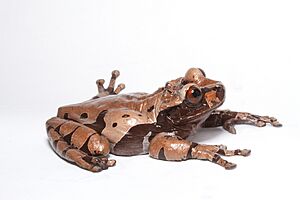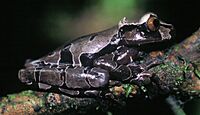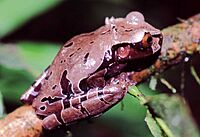Spiny-headed tree frog facts for kids
Quick facts for kids Spiny-headed tree frog |
|
|---|---|
 |
|
| Conservation status | |
| Scientific classification | |
| Synonyms | |
|
The spiny-headed tree frog (scientific name: Triprion spinosus) is a unique type of frog that belongs to the Hylidae family. You can find this special frog in different parts of Panama, Costa Rica, Honduras, and southern Mexico. It got its common name because of the many sharp points on its head and back.
About the Spiny-Headed Tree Frog
This frog is quite large for a tree frog. It can grow to be about 5.8 to 8 centimeters (2.3 to 3.1 inches) long from its snout to its rear end. It has many sharp, pointed bumps on its head and back, which is why it's called the spiny-headed tree frog.
The skin on its head is actually joined to its skull. It also has a very big eardrum, called a tympanum. Its legs are long and thin, and its toes have sticky pads on the tips. These pads help it climb and hold onto surfaces.
The frog's back is usually light brown or gray with darker marks. Its sides are dark brown or black. A thin white line separates these colors.
Life and Habits of the Spiny-Headed Tree Frog
This frog is most active at night. You are more likely to hear the male's call, which sounds like "boop...boop...boop," than to see the frog itself. The male frog calls from next to a temporary pool of water. This could be a water-filled hollow in a tree or water collected in a bromeliad plant. This is also where the female lays her eggs.
The young frogs, called tadpoles, are safe from big predators like fish in these small pools. However, there isn't much food for them. The female frog has a clever way to solve this problem! She visits each place where she laid eggs regularly. Then, she lays unfertilized eggs for her tadpoles to eat. The tadpoles encourage her to do this by gently nibbling at her belly. Sometimes, up to sixteen tadpoles can be found living in one of these small, temporary water spots.
Where They Live and How We Protect Them
The spiny-headed tree frog lives in lowland rainforests and humid mountain forests. They can be found at heights from about 95 to 2000 meters (310 to 6,560 feet) above sea level. In places like Costa Rica and Panama, they can also live in younger forests that are growing back, and even in coffee farms far from the main forest. They breed in holes found in trees.
These frogs are at risk because their natural homes are being cleared and changed into open areas. Luckily, they live in several protected areas. There is also a special program to help them. A group of these frogs is kept and bred in places like the El Valle Amphibian Conservation Center in Panama, the Atlanta Botanical Garden in the United States, and some AZA zoos. This helps create an "insurance population" to make sure the species survives.




